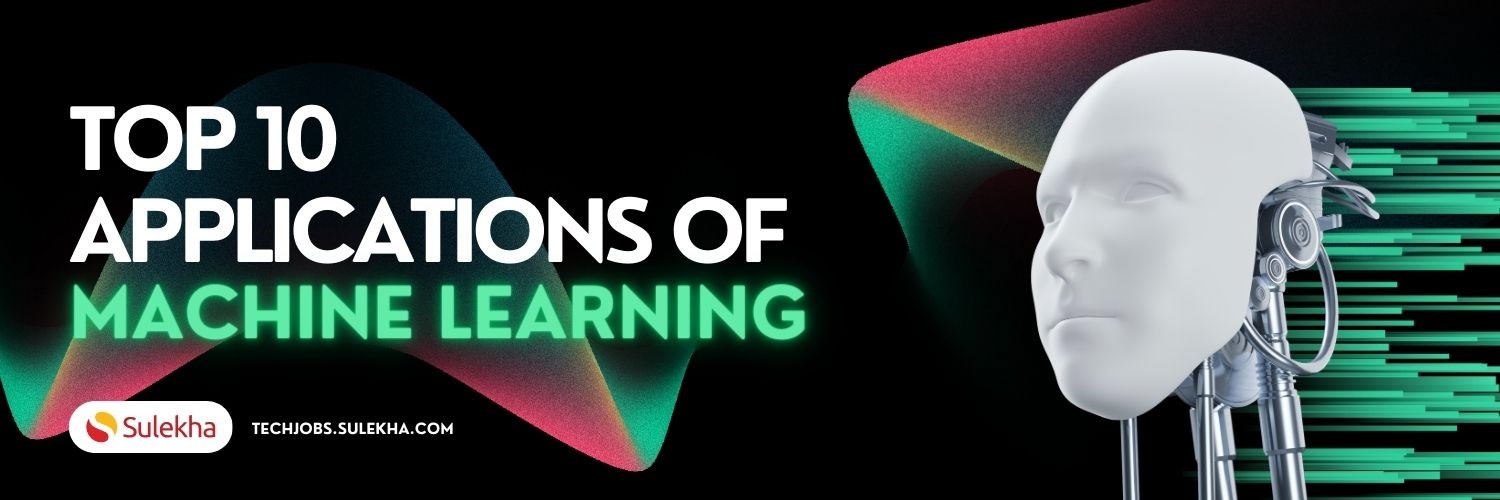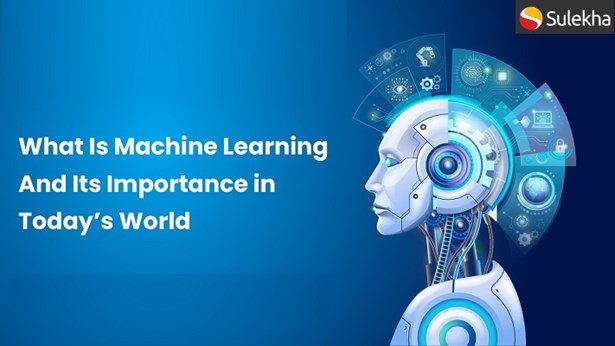Top 10 Applications of Machine Learning

Machine learning is a demanding career path for several reasons. Firstly, the demand for machine learning professionals is increasing rapidly as more industries leverage the applications of machine learning and artificial intelligence, which all comes under data science. Additionally, the shortage of skills required by businesses in the AI field, particularly in the IT industry, further emphasizes the increasing demand for machine learning experts. Overall, the demand for machine learning professionals is fueled by the rapid growth of AI applications across industries, making it a lucrative and promising career choice for individuals interested in this field.
According to a 2019 report by Indeed, the Machine Learning Engineer is the number one job in salary, posting growth, and general demand.
According to Statista:
· The market size in the Machine Learning market is projected to reach US$79.29bn in 2024.
· The machine learning market is poised for exponential growth, with an expected annual growth rate (CAGR 2024-2030) of 36.08%. This projection could result in a staggering market volume of US$503.40bn by 2030, indicating the long-term viability and potential of a career in machine learning.
· In global comparison, the largest market size will be in the United States (US$21.14bn in 2024).
What is Machine Learning?
Machine learning is a subfield of artificial intelligence (AI) that focuses on enabling machines to learn and improve from data analysis without explicit programming. It is a discipline that allows machines to learn, grow, develop, and adapt to new data. Machine learning algorithms are molded on a training dataset to create a model, which is then used to predict new input data. The performance of ML algorithms adaptively improves with an increase in available samples during the 'learning' process.
Machine learning has numerous applications across various industries, including computational finance, computer vision, computational biology, automotive, aerospace, manufacturing, and natural language processing. It is a promising field with significant potential to derive business value from the available data.
Now, we shall discuss the applications of machine learning.
1. Social Media Features
All social media platforms utilize machine learning and its algorithms to create valuable features for their organizations' growth.
For example:
Facebook—As we know, Facebook is a worldwide social media platform. We are not aware of how it records and monitors user activities. All activities include chatting, the time we spend, comments, likes, posts, updates, everything. Machine learning learns user activities and their likes and dislikes and pops up friends and page suggestions for your profile.
2. Product Recommendations
Product recommendation is one of the popular applications of machine learning. It is a unique feature utilized by almost every organization, particularly e-commerce sites, in the booming digital marketing field.
This product recommendation is an advanced application of ML. We can monitor and track our website behavior based on previous purchases, cart history, and search patterns using this advanced machine learning and artificial intelligence application technique.
3. Image Recognition
Image recognition is one of the popular applications of machine learning. Machine learning is used in image recognition to train models that can automatically identify and classify objects within images. One common approach is convolutional neural networks (CNNs), specifically designed to work with image data. These models learn to extract features from images and make predictions based on those features.
For example, in a facial recognition system, a CNN can be trained on a dataset of images with labeled faces to learn to distinguish between different individuals. As the model is trained on more data, it becomes better at recognizing patterns and making accurate predictions, enabling it to identify faces in new images with high accuracy.
By training the model on a large dataset of labeled MRI images, it can learn to recognize patterns associated with different types of abnormalities. Once trained, the model can be used to automatically analyze new MRI scans and flag any areas of concern for further review by medical professionals. This image recognition application speeds up the diagnostic process and helps in early detection of health issues.
4. Sentiment Analysis
Sentiment analysis is a machine learning technique used to analyze and classify the emotional tone of text data as positive, negative, or neutral. It is also known as opinion mining or emotion artificial intelligence. Sentiment analysis models use natural language processing (NLP) and machine learning to determine the overall sentiment conveyed by a particular text, phrase, or word, expressed as a numerical rating known as a "sentiment score."
For example:
Sentiment analysis is used in various applications, such as customer feedback analysis, brand monitoring, market research, and social media sentiment tracking, providing valuable insights for businesses to make data-driven decisions and understand customer perceptions effectively. Sentiment analysis can be applied to everything from brand monitoring to market research and HR, helping companies to glean deeper insights, become more competitive, and better understand their customers.
5. Automating Employee Access Control
Automating Employee Access Control is a top application of machine learning used by organizations to determine the level of access employees need based on their job profiles. Machine learning algorithms analyze and classify employees based on their roles, responsibilities, and job requirements and then automatically grant or revoke access to specific systems, applications, or data.
For example:
Amazon launched a machine learning contest on Kaggle to develop an automated employee access control system to predict which employees should be granted access to restricted areas based on their job profiles and behavior patterns. Other organizations, such as Key Dynamics Solutions and Bytecode, offer machine learning-based access control solutions to automate granting and revoking employee access.
6. Regulating Healthcare Efficiency and Medical Services
Many healthcare sectors are actively implementing machine learning algorithms for better organization management. These algorithms can predict patient waiting across various departments in the hospital.
Machine learning is used in healthcare to draw insights from large medical data sets, improve patient outcomes, automate healthcare professionals' daily workflows, accelerate medical research, and increase operational efficiency. It is used in various applications such as disease outbreak prediction, drug discovery, hospital management optimization, and the development of better diagnostic tools to analyze medical images.
Machine learning can improve diagnosis, develop new treatments, reduce costs, enhance data security, and improve patient care. It can also help automate medical billing, clinical decision support, and the development of clinical practice guidelines within health systems.
For example:
Johns Hopkins Hospital, Cleveland Clinic, and UCLA Medical Center are among the top hospitals in the United States using machine learning.
7. Self-driving cars
One of the best machine learning applications is self-driving cars.
For example:
Companies like Tesla, Waymo, and Uber use machine learning in their self-driving car technologies, vehicle design, and supply chain management.
8. Email Spam and Malware Filtering
Whenever we get a new email, it's sorted out as important, normal, or spam. The important ones appear in our inbox with a special symbol, while the spammy ones go straight to the spam folder. This whole system works due to Machine Learning.
Below are some spam filters used by Gmail
· Blacklist filtering
· Content filtering
· Link reputation filtering
· Machine learning
· Sender reputation
· Recipient behavior
Some machine learning algorithms, such as:
Multi-Layer Perceptron
Decision tree
Naïve Bayes classifier
These are the most crucial machine-learning algorithms for email spam filtering and malware detection.
9. Virtual Personal Assistant:
Machine learning enables Virtual Personal Assistants to understand user queries, personalize responses, and improve accuracy through continual learning from user interactions. Natural Language Processing (NLP) algorithms process spoken or typed commands, while data analysis drives adaptation to individual preferences, optimizing performance and usability.
Many products incorporate virtual personal assistants; here are a few examples:
· Smartphones: Most modern smartphones have built-in virtual assistants, such as Apple's Siri, Google Assistant, or Samsung's Bixby.
· Smart speakers: Smart speakers like Amazon Echo (with Alexa), Google Home (with Google Assistant), and Apple HomePod (with Siri) are voice-activated devices.
· Smart displays: Smart displays are smart speakers with screens.
· Smartwatches: Some smartwatches, such as the Apple and Samsung Galaxy Watch, also have built-in virtual assistants.
10. Banking Domain
Nowadays, encrypting banking details has become a common issue facing any Bank in any corner of the world. To secure banking details or customer data from malware hackers, banks use machine learning applications to protect them from fraud.
The algorithms ascertain the relevant factors for establishing a filter to mitigate harm. Unauthorized websites will be automatically filtered and prohibited from engaging in transactions.
For example:
These Machine learning applications are commonly used for fraud detection in banking.
· Logistic regression
· Decision trees
· Random forest
· Support vector machines (SVMs)
11. Language Translation
Machine learning is a translator's secret weapon for VPAs. It analyzes these pairs, learning the connections between words and phrases across languages. Over time, it can use this knowledge to translate new sentences on its own, even accounting for slang or unusual phrasing—just like a seasoned translator getting better with experience!
For example:
Here are some products that leverage machine learning for language translation:
· Google Translate
· Microsoft Translator
· DeepL
· Waygo
· Skype
There are two primary machine-learning applications used for language translation:
1. Statistical Machine Translation (SMT)
2. Neural Machine Translation (NMT)
Moreover, various machine learning applications are springing into our everyday lives, and new technologies have emerged due to the implementation of machine learning and Artificial intelligence in every sector, from the Government to the IT sectors.
In conclusion, machine learning is a cornerstone of modern innovation, offering solutions to complex problems and unlocking new possibilities across diverse fields. Its capacity to derive insights from data, adapt to changing circumstances, and augment human capabilities underscores its significance in shaping the digital landscape. As we harness its potential responsibly and ethically, machine learning will undoubtedly remain at the forefront of driving progress, fostering creativity, and improving the quality of life for individuals and society.
Find a course provider to learn Machine Learning
Java training | J2EE training | J2EE Jboss training | Apache JMeter trainingTake the next step towards your professional goals in Machine Learning
Don't hesitate to talk with our course advisor right now
Receive a call
Contact NowMake a call
+1-732-338-7323Take our FREE Skill Assessment Test to discover your strengths and earn a certificate upon completion.
Enroll for the next batch
best machine learning course for beginners
- Dec 12 2025
- Online
best machine learning course for beginners
- Dec 15 2025
- Online
best machine learning course for beginners
- Dec 16 2025
- Online
best machine learning course for beginners
- Dec 17 2025
- Online
best machine learning course for beginners
- Dec 18 2025
- Online
Related blogs on Machine Learning to learn more

How Machine Learning Applications Revolutionizes Everyday Technology and Business
Discover the vast range of machine learning applications across industries and learn how machine learning is transforming businesses and revolutionizing the way we live and work.

What is computer vision? A complete Tutorial
Learn about computer vision in this comprehensive tutorial covering image processing, object detection, and more. Explore the fundamentals and applications of computer vision with practical examples and insights.

What is Machine Learning?
ML is the branch of artificial intelligence

Data Science and Machine Learning - The future impact in the world of healthcare
Data Science and Machine Learning - The future impact in the world of healthcare

Adidas now allows consumers to design shoes by themselves
Adidas, a world-famous sports brand, is now banking on machine learning technology to understand consumer trends and preferences and incorporate it into its wide-spread supply chain. What this move does is it allows their customers to design the prod
Latest blogs on technology to explore

From Student to AI Pro: What Does Prompt Engineering Entail and How Do You Start?
Explore the growing field of prompt engineering, a vital skill for AI enthusiasts. Learn how to craft optimized prompts for tools like ChatGPT and Gemini, and discover the career opportunities and skills needed to succeed in this fast-evolving indust

How Security Classification Guides Strengthen Data Protection in Modern Cybersecurity
A Security Classification Guide (SCG) defines data protection standards, ensuring sensitive information is handled securely across all levels. By outlining confidentiality, access controls, and declassification procedures, SCGs strengthen cybersecuri

Artificial Intelligence – A Growing Field of Study for Modern Learners
Artificial Intelligence is becoming a top study choice due to high job demand and future scope. This blog explains key subjects, career opportunities, and a simple AI study roadmap to help beginners start learning and build a strong career in the AI

Java in 2026: Why This ‘Old’ Language Is Still Your Golden Ticket to a Tech Career (And Where to Learn It!
Think Java is old news? Think again! 90% of Fortune 500 companies (yes, including Google, Amazon, and Netflix) run on Java (Oracle, 2025). From Android apps to banking systems, Java is the backbone of tech—and Sulekha IT Services is your fast track t

From Student to AI Pro: What Does Prompt Engineering Entail and How Do You Start?
Learn what prompt engineering is, why it matters, and how students and professionals can start mastering AI tools like ChatGPT, Gemini, and Copilot.

Cyber Security in 2025: The Golden Ticket to a Future-Proof Career
Cyber security jobs are growing 35% faster than any other tech field (U.S. Bureau of Labor Statistics, 2024)—and the average salary is $100,000+ per year! In a world where data breaches cost businesses $4.45 million on average (IBM, 2024), cyber secu

SAP SD in 2025: Your Ticket to a High-Flying IT Career
In the fast-paced world of IT and enterprise software, SAP SD (Sales and Distribution) is the secret sauce that keeps businesses running smoothly. Whether it’s managing customer orders, pricing, shipping, or billing, SAP SD is the backbone of sales o

SAP FICO in 2025: Salary, Jobs & How to Get Certified
AP FICO professionals earn $90,000–$130,000/year in the USA and Canada—and demand is skyrocketing! If you’re eyeing a future-proof IT career, SAP FICO (Financial Accounting & Controlling) is your golden ticket. But where do you start? Sulekha IT Serv

Train Like an AI Engineer: The Smartest Career Move You’ll Make This Year!
Why AI Engineering Is the Hottest Skillset Right Now From self-driving cars to chatbots that sound eerily human, Artificial Intelligence is no longer science fiction — it’s the backbone of modern tech. And guess what? Companies across the USA and Can

Confidence Intervals & Hypothesis Tests: The Data Science Path to Generalization
Learn how confidence intervals and hypothesis tests turn sample data into reliable population insights in data science. Understand CLT, p-values, and significance to generalize results, quantify uncertainty, and make evidence-based decisions.